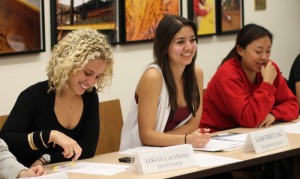Despite national trend, women well represented in USC student government
For the first time in three decades, the total number of female legislators is dropping — the solution, some say, is to increase the number of women involved in student government.

Working · Logan Lachman, vice-president elect, and Sam Freitag, 2010-2011 USG residential senator, are some of the females involved in USG. A recent study found less than a third of student presidents nationwide are women. - Robin Laird | Daily Trojan
But although men have traditionally dominated the student government ranks, USC’s Undergraduate Student Government, maintains a strong female presence.
“Our staff is just about a 50-50 split between males and females,” said Maya Babla, former USG chief of staff.
Among the top 50 colleges ranked by U.S. News & World Report, less than one-third of the student body presidents are women, according to a finding released by the American Student Government Association.
Although the overall balance of men and women in USG is fairly equal, since spring 2006 none of the 18 candidates for USG president and only one-third of the candidates for USG vice president have been female. The last female candidate to run for president was Jessica Lall, who was elected in 2005.
Logan Lachman, who won the vice president spot this year and will be sworn into office Tuesday, said she believes there are stereotypes about females in elected offices.
“Unfortunately, I do believe there are stereotypes associated with women in power. There is always a common misconception that women are weaker than men and therefore don’t make strong leaders,” Lachman said. “These stereotypes can affect voters as well as potential future candidates.”
American University’s Women & Politics Institute found that in 2006, 72 percent of students involved in the university’s student government were male.
Ava Lubell, the political director of the institute, told the Daily Trojan last year that women of all ages are less likely to see themselves as good candidates.
“Women need to be asked to run,” Lubell told the Daily Trojan. “They’re less likely to perceive themselves as being recruited, so you need to say explicitly, ‘We think you should run.’”
In Congress, women make up only 17 percent of members. Women make up 28 percent of the California Legislature and 23 percent of state legislators nationwide. Six of the nation’s governors, or 12 percent, are women, according to the National Foundation of Women Legislators.
“Quite honestly, I don’t think you’d be able to find these gender differences [at USC], and perhaps that’s an indication of the gender barrier being broken down a little further for our generation,” Babla said.
Though times have changed since women fought for the right to vote, traditional roles might continue to influence the role of gender in politics.
“I think a lot of things, other than their stance on issues, play a part in how a female candidate is perceived,” Babla said. “Voters still stereotype women candidates in some ways, and seek to better understand these ladies in terms of their family roles.”
Lachman said she has not found women to be shy about getting involved in student government at USC.
”We’ve never really had a problem getting female participation,” she said.

This is ludicrous, out of the past 50 Student body presidents USC has had, only 7 have been women.
That’s right, only 7. Don’t believe me? Email USG and ask them for the stats.
Pathetic
“Told the Daily Trojan” — twice? Does that mean all the other interviews in this article were for ATVN?
Women are holding there own! It’s nice to here…! Great article.
excellent article! Well written and very interesting!!!!
Actually, the information you’ve quoted is not accurate. ASGA’s research on every student government in America shows that nearly 52 percent of “student government” officers and members nationwide are women. About 40 percent of student government presidents are women. This is according to the American Student Government Association’s annual research on student governments through the United States.
While the American Student Government Association is a reliable organization that supports collegiate student governments nationwide their data takes into consideration community colleges, technical and trade city colleges, as well as graduate and professional schools. The statistic Butch Oxendine refers to was released by the U.S. News and World Report and is based off the top 50 colleges in America, not every college in America. Since USC is among the top 50, I found it more appropriate to compare USG with student government’s belonging to Universities of a similar stature and composition.